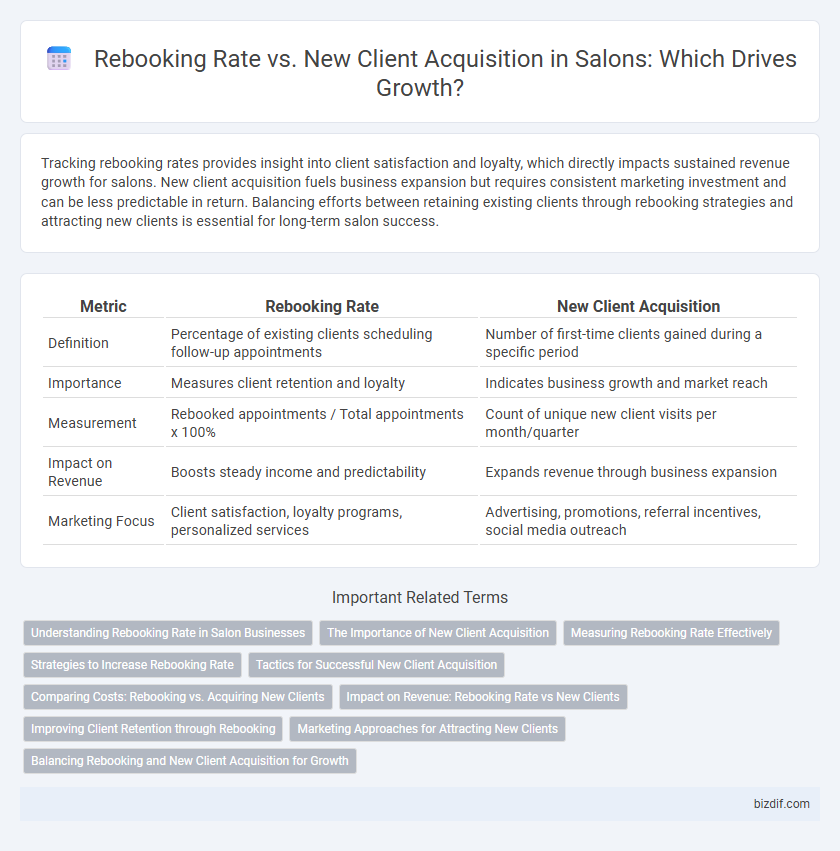Tracking rebooking rates provides insight into client satisfaction and loyalty, which directly impacts sustained revenue growth for salons. New client acquisition fuels business expansion but requires consistent marketing investment and can be less predictable in return. Balancing efforts between retaining existing clients through rebooking strategies and attracting new clients is essential for long-term salon success.
Table of Comparison
| Metric | Rebooking Rate | New Client Acquisition |
|---|---|---|
| Definition | Percentage of existing clients scheduling follow-up appointments | Number of first-time clients gained during a specific period |
| Importance | Measures client retention and loyalty | Indicates business growth and market reach |
| Measurement | Rebooked appointments / Total appointments x 100% | Count of unique new client visits per month/quarter |
| Impact on Revenue | Boosts steady income and predictability | Expands revenue through business expansion |
| Marketing Focus | Client satisfaction, loyalty programs, personalized services | Advertising, promotions, referral incentives, social media outreach |
Understanding Rebooking Rate in Salon Businesses
Rebooking rate in salon businesses measures the percentage of clients scheduling their next appointment before leaving, directly impacting client retention and long-term revenue stability. A high rebooking rate signifies strong client satisfaction and service consistency, reducing marketing costs compared to acquiring new clients. Optimizing rebooking strategies enhances predictable cash flow and strengthens customer loyalty, essential metrics for salon growth and competitiveness.
The Importance of New Client Acquisition
New client acquisition fuels the salon's growth by expanding the customer base and increasing revenue potential beyond the limits of rebooking existing clients. A strategic focus on targeted marketing and exceptional service quality attracts fresh clientele, which balances income fluctuations and boosts brand visibility in competitive markets. High new client acquisition rates correlate strongly with sustained business expansion and long-term profitability in the beauty industry.
Measuring Rebooking Rate Effectively
Measuring rebooking rate effectively involves tracking the percentage of clients who schedule their next appointment before leaving the salon, providing a clear indicator of customer satisfaction and loyalty. Using salon management software to automate rebooking reminders and record client visit frequency enhances accuracy and reduces manual errors. Comparing rebooking rate data with new client acquisition metrics offers insights into retention success and helps balance marketing efforts to optimize overall salon growth.
Strategies to Increase Rebooking Rate
Increasing the rebooking rate in salons significantly boosts client retention and long-term revenue stability. Personalized follow-up communications, such as appointment reminders and tailored promotions, encourage clients to schedule their next visit promptly. Offering loyalty programs and service packages provides added value, motivating clients to rebook while reducing dependence on costly new client acquisition efforts.
Tactics for Successful New Client Acquisition
Effective new client acquisition in salons relies on targeted marketing strategies such as social media campaigns, referral programs, and local partnerships. Offering first-time client discounts and personalized consultation increases booking conversions and enhances customer experience. Tracking acquisition KPIs alongside rebooking rates ensures balanced growth and sustained revenue streams.
Comparing Costs: Rebooking vs. Acquiring New Clients
Rebooking existing clients typically costs 5 to 7 times less than acquiring new clients, making retention strategies more cost-effective for salons. The average acquisition cost for new clients can range from $30 to $150, depending on marketing channel investments, while rebooking relies primarily on personalized service and loyalty incentives with lower overhead. Prioritizing a high rebooking rate enhances profitability by maximizing lifetime client value and reducing marketing expenses.
Impact on Revenue: Rebooking Rate vs New Clients
Higher rebooking rates significantly boost salon revenue by ensuring steady, repeat business and reducing customer acquisition costs. New client acquisition drives growth but often involves higher marketing expenses and unpredictable retention, impacting profitability. Balancing a strong rebooking strategy with effective new client acquisition maximizes sustainable revenue streams for salons.
Improving Client Retention through Rebooking
Improving client retention through rebooking drives higher lifetime value by encouraging repeat visits and consistent revenue streams. Tracking the rebooking rate provides insight into customer satisfaction and loyalty compared to new client acquisition costs. Prioritizing strategies such as appointment reminders and personalized service increases rebooking rates, reducing reliance on acquiring costly new clients.
Marketing Approaches for Attracting New Clients
Marketing approaches for attracting new clients in salons leverage targeted social media campaigns, influencer partnerships, and localized online advertising to increase visibility and engagement. Offering first-time client promotions and referral incentives also significantly boosts new client acquisition by encouraging trial and word-of-mouth recommendations. Data-driven strategies involving customer demographics and behavior analysis optimize ad spend, enhancing the effectiveness of new client marketing efforts.
Balancing Rebooking and New Client Acquisition for Growth
Maximizing salon growth requires balancing a high rebooking rate with effective new client acquisition strategies. A consistent rebooking rate above 70% ensures steady revenue and client loyalty, while targeted marketing campaigns and referral incentives attract fresh clientele. Monitoring both metrics and adjusting service quality and promotion efforts drive sustainable salon expansion.
Rebooking Rate vs New Client Acquisition Infographic

 bizdif.com
bizdif.com